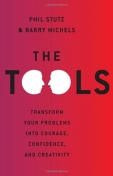BKMT READING GUIDES
The Tools: Transform Your Problems into Courage, Confidence, and Creativity
by Phil Stutz, Barry Michels
Hardcover : 288 pages
0 club reading this now
0 members have read this book
The Tools offers a solution to the biggest complaint patients have about therapy: the interminable wait for change to begin. The ...
Introduction
A groundbreaking book about personal growth that presents a uniquely effective set of five tools that bring about dynamic change?as seen on The Dr. Oz Show
The Tools offers a solution to the biggest complaint patients have about therapy: the interminable wait for change to begin. The traditional therapeutic model sets its sights on the past, but Phil Stutz and Barry Michels employ an arsenal of techniques??the tools??that allow patients to use their problems as levers that access the power of the unconscious and propel them into action. Suddenly, through this transformative approach, obstacles become opportunities?to find courage, embrace discipline, develop self-expression, deepen creativity.
For years, Stutz and Michels taught these techniques to an exclusive patient base, but with The Tools, their revolutionary, empowering practice becomes available to every reader interested in realizing the full range of their potential. The authors? goal is nothing less than for your life to become exceptional?exceptional in its resiliency, in its experience of real happiness, and in its understanding of the human spirit.
?An ?open secret? in Hollywood . . . [Stutz and Michels] have developed a program designed to access the creative power of the unconscious.??The New Yorker
A Letter from the Authors: What Is a Tool?
 In conventional psychotherapy, we talk about ?insights? or ?causation? and we tend to believe that if we can uncover the deep-seated reasons behind someone's problems, then the person will change automatically. This implies that awareness alone creates the forces that cause change. But real change, the kind of change patients in therapy cry out for, means changing your behavior, not just your attitude.
In conventional psychotherapy, we talk about ?insights? or ?causation? and we tend to believe that if we can uncover the deep-seated reasons behind someone's problems, then the person will change automatically. This implies that awareness alone creates the forces that cause change. But real change, the kind of change patients in therapy cry out for, means changing your behavior, not just your attitude. That requires much stronger forces. A tool is a technique or procedure that can generate a force that allows you to do the work of change. It is work that must be done in real time. When do we use a tool? In the present.
Conventional therapy tends to be passive and focuses on the past. It excavates a patient's history, usually from childhood, brings it into the light of day and interprets it so as to strip it of its unconscious power. I have the greatest respect for the past. Memories, emotions, insights can all be very valuable. But my patients needed help and relief in the present and all the insights in the world weren?t going to be powerful enough to deliver that.
To control your actions you need something else: a specific procedure you can use systematically to combat a specific problem -- you need a tool.
There's an obvious objection that arises here: Isn?t what you?re doing superficial? Sure, these tools of yours may help a patient change his or her behavior but you haven?t addressed the underlying reasons. Unless you do that they?re bound to go back to their (self-) destructive ways sooner or later.
There are two answers to this objection. The first involves a misunderstanding of how people change. Insight into the ?reasons? for a problem isn?t the cause of change ? it's the result. Groups like Alcoholics Anonymous have always known this. You don?t join AA and then sit around discussing why you drink too much over a few beers or vodka martinis. You join to stop drinking one day at a time. Only after that can you look into the roots of your addiction by ?taking inventory.?
The second answer goes back to our original question about what a tool is. There has been a bias in psychotherapy implying that anything that is active and involves your will is superficial; as if the deepest part of human experience can only occur inside your head. The truth is the opposite; the deepest part of human experience happens when you interact with the world outside yourself. That means you need to go beyond thinking and into ?doing??and this is exactly what a tool makes possible.
Discussion Questions
No discussion questions at this time.Book Club Recommendations
Recommended to book clubs by 0 of 0 members.
Book Club HQ to over 90,000+ book clubs and ready to welcome yours.
Get free weekly updates on top club picks, book giveaways, author events and more








